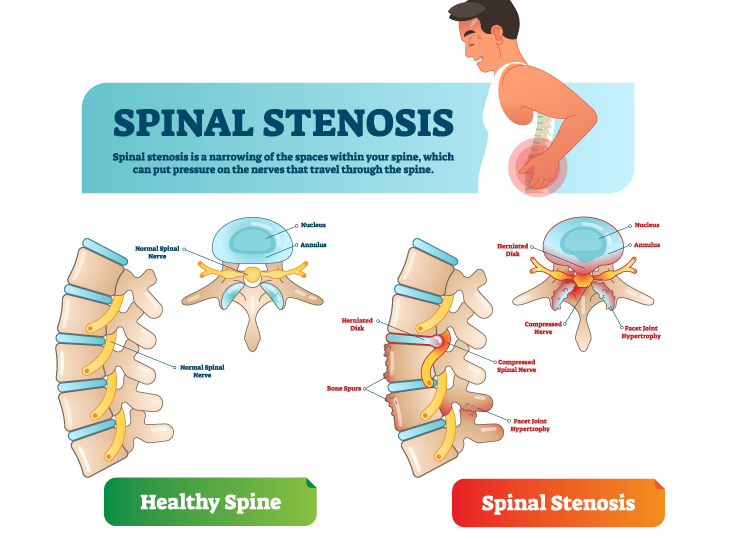 From WebMD
From WebMD
Cervical Spinal Stenosis
Spinal stenosis is a condition, mostly in adults 50 and older, in which your spinal canal starts to narrow. This can cause pain and other problems.
Your spine is made up of a series of connected bones (or “vertebrae”) and shock-absorbing discs. It protects your spinal cord, a key part of the central nervous system that connects the brain to the body. The cord rests in the canal formed by your vertebrae.
For most people, the stenosis results from changes because of arthritis. The spinal canal may narrow. The open spaces between the vertebrae may start to get smaller. The tightness can pinch the spinal cord or the nerves around it, causing pain, tingling, or numbness in your legs, arms, or torso. Read more

Work-from-Home Ergonomics 101: Setting Up Your Remote Office
in Ergonomics, Working From Home- TipsFrom Rachel Pelta at FlexJobs
Since many of us are working at home right now (and weren’t expecting it), lots of people are improvising their “workstation.” For some, that means working at a desk, and for others, that means sitting on the couch or commandeering the kitchen table during work hours.
We’ve got some advice on how to set up an ergonomic workspace at home. While it’s best if you can buy the right equipment, that doesn’t mean you have to. Sometimes simple works, so we’ve included some DIY work-from-home ergonomic hacks you can use with things you’ve probably got at home. Read more
20 Tips for Working from Home
in COVID-19, Working From Home- TipsWe found this great article on PCMag. by Jill Duffy and wanted to share… Great tips for working from home!
The outbreak of the coronavirus has more people working from home than ever. If you’re new to working remotely, these tips from a home-office pro can help you stay productive and maintain balance. Read more
What is Spinal Stenosis?
in Spinal Stenosis, Spinal Surgery, SpineCervical Spinal Stenosis
Spinal stenosis is a condition, mostly in adults 50 and older, in which your spinal canal starts to narrow. This can cause pain and other problems.
Your spine is made up of a series of connected bones (or “vertebrae”) and shock-absorbing discs. It protects your spinal cord, a key part of the central nervous system that connects the brain to the body. The cord rests in the canal formed by your vertebrae.
For most people, the stenosis results from changes because of arthritis. The spinal canal may narrow. The open spaces between the vertebrae may start to get smaller. The tightness can pinch the spinal cord or the nerves around it, causing pain, tingling, or numbness in your legs, arms, or torso. Read more
Risk Factors and Common Causes of Lower Back Pain
in Back PainArticle from City Hospital at White Rock
Eighty percent of adults will suffer from lower back pain during their lifetime according to an epidemiology study published by the National Institutes of Health. Lower back pain is the second-most common cause of job-related disability and time off of work. Most chronic sufferers turn to medications, heating pads, and massage to relieve their aches, but when is the right time to see an orthopedic surgeon?
Do you suffer from lower back pain? You’re not alone. In this guide, we will discuss the common causes of lower back pain and how an orthopedic surgeon can help you. Read more
How The Spinal Cord Works
in Spinal Surgery, SpineArticle shared from ChristopherReeve.org
What is the central nervous system?
The central nervous system (CNS) controls most functions of the body and mind. It consists of two parts: the brain and the spinal cord.
The brain is the center of our thoughts, the interpreter of our external environment, and the origin of control over body movement. Like a central computer, it interprets information from our eyes (sight), ears (sound), nose (smell), tongue (taste), and skin (touch), as well as from internal organs such as the stomach.
Read more
Bones Are Growing Faster, Affecting Orthopedics
in General OrthopedicsRead more
Close-to-Home: Forest Park’s Trails in the Time of Coronavirus
in Portland Area, Portland – Hiking and RecreationArticles shared from The Forest Park Conservancy
Please note: As the issue of park access and facilities related to COVID-19 is rapidly evolving, FPC recommends community members adhere to all guidelines and recommendations from the Centers for Disease Control and Prevention (CDC) and your local public health officials for the most up-to-date information.
Read more
Neck Pain Red Flags and When Not To Worry
in Neck PainArticle by Paul Ingraham | Featured on Pain Science
We fear spine pain more than we fear other kinds of pain. Backs and necks seem vulnerable. And yet most spinal pain does not have a serious cause. The bark of neck pain is usually worse than its bite. This article explains how to tell the difference.
Please do seek care immediately if you’ve been in an accident or you have very severe or weird pain or other symptoms — obviously. This article is for non-emergency situations. But if you have neck pain that’s been starting to worry you, this is a good place to get some reassurance and decide whether or not to talk to a doctor.
Read more
Creative Tips to Help You Stay Hydrated Throughout The Day
in Nutrition & General HealthRead more
All About Foot Pain
in Feet, Foot Pain